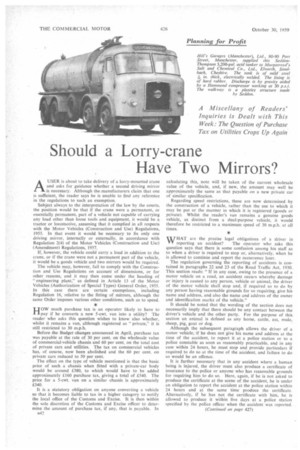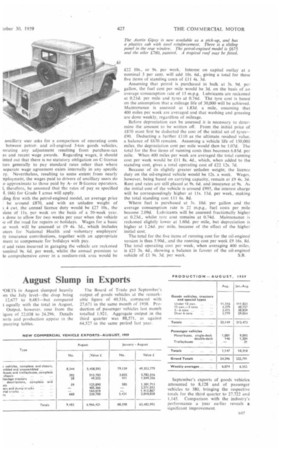Should a Lorry-crane Have Two Mirrors?
Page 76

Page 79

If you've noticed an error in this article please click here to report it so we can fix it.
AUSER is about to take delivery of a lorry-mounted crane and asks for guidance whether a second driving mirror is necessary. Although the manufacturers claim that one is sufficient, the reader says he is unable to And any reference in the regulations to such an exemption.
Subject always to the interpretation of the law by the courts, the position would be that if the crane were a permanent, or essentially permanent, part of a vehicle not capable of carrying any load other than loose tools and equipment, it would be a tractor or locomotive, assuming that it complied in all respects with the Motor Vehicles (Construction and Use) Regulations, 1955. In that event it would be necessary to fix only one driving mirror, internally or externally, in accordance with Regulation 2(4) of the Motor Vehicles (Construction and Use) (Amendment) Regulations, 1957.
If, however, the vehicle could carry a load in addition to the crane, or if the crane were not a permanent part of the vehicle, it would be a goods vehicle and two mirrors would be required.
The vehicle may, however, fail to comply with the Construction and Use Regulations on account of dimensions, or for other reasons, and it may then come under the heading of "engineering plant," as defined in Article 13 of the Motor Vehicles (Authorization of Special Types) General Order, 1955. In this case there are certain exemptions, including Regulation 16, relative to the fitting of mirrors, although the same Order imposes various other conditions, such as to speed.
HOW much purchase tax is an operator likely to have to pay if he converts a new 5-cwt. van into a utility? The reader who asks this question wishes to know also whether, whilst it remains a van, although registered as "private," it is still restricted to 30 m.p.h.
Before the Budget changes announced in April, purchase tax was payable at the rate of 30 per cent, on the wholesale value of commercial-vehicle chassis and 60 per cent, on the total cost of private cars and utilities. The tax on commercial vehicles has, of course, now been abolished and the 60 per cent, on private cars reduced to 50 per cent.
The effect on the type of vehicle mentioned is that the basic price of such a chassis when fitted with a private-car body would be around £380, to which would have to be added approximately £160 purchase tax, giving a total of £540. The price for a 5-cwt. van on a similar chassis is approximately £340.
It is a statutory obligation on anyone converting a vehicle so that it becomes liable to tax in a higher category to notify the local office of the Customs and Excise. It is then within the sole discretion of the Customs and Excise officer to determine the amount of purchase tax, if any, that is payable. In
n4/ calculating this, note will be taken of the current wholesale value of the vehicle, and, if new, the amount may well be approximately the same as that payable on a new private car of similar specification.
Regarding speed restrictions, these are now determined by the construction of a vehicle, rather than the use to which it may be put or the manner in which it is registered (goods or private). Whilst the reader's van remains a genuine goods vehicle, as distinct from a dual-purpose vehicle, it would therefore be restricted to a maximum speed of 30 m.p.h. at all times.
WHAT are the precise legal obligations of a driver in
reporting an accident? The operator who asks this question says that there is some confusion among his staff as to when a driver is required to stop or. alternatively, when he is allowed to continue and report the occurrence later.
The regulation governing the reporting of accidents is contained in paragraphs 22 and 23 of the Road Traffic Act, 1930. This section reads: "If in any case, owing to the presence of a motor vehicle on a road, an accident occurs whereby damage or injury is caused to any person, vehicle or animal, the driver of the motor vehicle shall stop and, if required so to do by any person having reasonable grounds for so requiring, give his name and address, and also the name and address of the owner and identification marks of the vehicle."
It should be noted that the wording of the section does not necessarily imply that there should be any contact between the driver's vehicle and the other party. For the purpose of this section an animal is defined as any horse, cattle, ass, mule, sheep, pig, goat or dog.
Although the subsequent paragraph allows the driver of a motor vehicle, if he -does not give his name and address at the time of the accident, to report it at a police station or to a police constable as soon as reasonably practicable, and in any case within 24 hours, he must stop and provide particulars if required to do so at the time of the accident, and failure to do so would be an offence.
It is further necessary that in any accident where a human being is injured, the driver must also produce a certificate of insurance to the ,police or anyone who has reasonable grounds for requiring him to do so. Here, again, if he is not asked to produce the certificate at the scene of the accident, he is under an obligation to report the accident at the police station within 24 hours and at the same time produce the certificate. Alternatively, if he has not the certificate with him, he is allowed to produce it within five days at a police station specified by the police officer when the accident was reported.
ancillary user asks for a comparison of operating costs between petrolan,c1 oil-engined 3-ton goods vehicles, torating any adjustment resulting from purchase-tax es and recent wage awards. Regarding wages, it should inted out that there is no statutory obligation on C-licence tors generally to pay standard rates other than where separate wage agreement exists internally in any specific ry. Nevertheless, resulting to some extent from nearly riployment, the wages paid to drivers of ancillary users do o approximate to those paid by Aor B-licence operators.
therefore, be assumed that the rates of pay as specified 4. (66) for Grade 1 areas will apply.
,ling first with the petrol-engined model, an average price ' be around £870, and with an unladen weight of ;.4 cwt. the annual licence duty would be £27 10s., the dent of Hs. per week on the basis of a 50-week year. s done to allow for two weeks per year when the vehicle le off the road for repairs or holidays, •Wages. for a basic ar week will be assessed at £9 4s, 3d., which includes inces for National Health and 'voluntary employers' ty insurance contributions, together with an appropriate ment to compensate for holidays with pay.
it and rates incurred in garaging the vehicle are reckoned tominal 9s. 6d. per week, whilst the annual premium to le comprehensive cover in a medium-risk area would be £22 10s., or 9s. per week. Interest on capital outlay at a nominal 3 per cent, will add 10s. 6d., giving a total for these five items of standing costs of £11 4s. 3d.
Assuming that petrol is purchased in bulk at 3s. 9d, per gallon, the fuel cost per mile would be 3d. on the basis of an average consumption rate of 15 m.p.g. Lubricants are reckoned at 0.21d. per mile and tyres. at 0.74d. The tyre cost is based on the assumption that a mileage life of 30,000 will be achieved. Maintenance is assessed at 1.83d. a mile, assuming that 400 miles per week are averaged and that washing and greasing are done weekly. regardless of mileage.
Before depreciation can be assessed it is necessary to determine the amount to be written off. From the initial price of £870 must first be deducted the cost of the initial set of tyres190. Deducting a further £110 as the ultimate residual value. a balance of £670 remains. Assuming a vehicle life of 150,000 miles, the depreciation cost per mile would then be 1.07d. The total for the five items of running costs thus becomes 6.85d. per mile. When 400 miles per week are averaged the total running cost per week would be £11 8s. 4d., which, when added to the standing cost, gives a total operating cost of £22 12s. 7d.
Because of its slightly greater unladen weight, the licence duty on the oil-engined vehicle would be 12s. a week. Wages, however, being based on carrying capacity, remain at £9 4s. 3d. Rent and rates are still placed at 9s. 6d. and insurance at 9s. As the initial cost of the vehicle is around £995, the interest charge will be correspondingly higher at 1 Is. 11d, per week, making the total standing cost ill 6s. 8d.
Where fuel is purchased at 3s. 10d. per gallon and the average consumption rate is 22 m.p.g., fuelcosts per mile become 2.09d. Lubricants will be assessed fractionally higher at 0.23d., whilst tyre cost remains at 0.74d. Maintenance is reckoned slightly lower at 1.60d, per mile, but depreciation is higher at 1.24d, per mile, because of the effect of the higher initial cost.
The total for the five items of running cost for the oil-engined version is thus 5.90d., and the running cost per week £9 16s. 8d, The total operating cost per week, when averaging 400 miles, is £21 3s. 4d., showing a balance in favour of the oil-engined vehicle of El 9s, 3d, per week, S.B.




















































































































